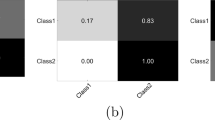Abstract
Collaborative representation has been successfully used in pattern recognition and machine learning. However, most existing collaborative representation classification methods are to achieve the highest classification accuracy, assuming the same losses for different misclassifications. This assumption, however, may not hold in many real-word applications as different types of misclassification could lead to different losses. Meanwhile, the class distribution of data is highly imbalanced in real-world applications. To address this problem, a novel Cost-Sensitive Collaborative Representation based Classification (CSCRC) method via Probability Estimation with Addressing the Class Imbalance was proposed. Unlike traditional methods, the class label of test samples is predicted by minimizing the misclassification losses which are obtained via computing the posterior probabilities. In this paper, a Gaussian function was defined as a probability distribution of collaborative representation coefficient vector and the probability distribution was transformed into collaborative representation framework via logarithmic operator. The experiments show that our proposed method performs competitively compared with existing methods.






Similar content being viewed by others
References
Blake C, Keogh E, Merz CJ UCI repository of machine learning databases. http://www.ics.uci.edu/∼mlearn/MLRepository.html, Department of Information and Computer Science, University of California, Irvine, CA
Cai S, Zhang L, Zuo W et al (2016) A Probabilistic Collaborative Representation based Approach for Pattern Classification. Comput Vis Pattern Recogn 2016:2950–2959
Cheng Y, Jin Z, Gao T, Chen H, Kasabow N (2016) An improved collaborative representation based classification with regularized least square (CRC–RLS) method for robust face recognition. Neurocomputing 215(C):250–259
EthemAlpayd (2011) Wiley Interdisciplinary Reviews Computational Statistics. Mach Learn 3(3):195–203
George NI, Lu TP, Chang CW (2016) Cost-sensitive performance metric for comparing multiple ordinal classifiers. Artif Intell Res 5(1):p135
Jiang L, Qiu C, Li C (2015) A novel minority cloning technique for cost-sensitive learning. Int J Pattern Recognit Artif Intell 29(4):18. https://doi.org/10.1142/S0218001415510040
Lan R, Yang J, Jiang Y, Song Z, Tang YY (2012) An affine invariant discriminate analysis with canonical correlation analysis. Neurocomputing 86:184–192
Lawrence N (2005) Probabilistic Non-linear Principal Component Analysis with Gaussian Process Latent Variable Models. J Mach Learn Res 6(3):1783–1816
Liu J, Wu Z, Li J et al (2015) Probabilistic-Kernel Collaborative Representation for Spatial–Spectral Hyperspectral Image Classification. IEEE Trans Geosci Remote Sens 54:1–14
Lu H, Li Y, Chen M, Kim H, Serikawa S (2017) Brain Intelligence: Go Beyond Artificial Intelligence. Mob Netw Appl 7553:1–8
Lu H, Li Y, Uemura T, Ge Z, Xu X et al (2017) FDCNet: filtering deep convolutional network for marine organism classification. Multimed Tools Appl 2017:1–14
Moghaddam B (2002) Principal manifolds and probabilistic subspaces for visual recognition. IEEE Trans Pattern Anal Mach Intell 24(6):780–788
Moghaddam B, Pentland A (2002) Probabilistic Visual Learning for Object Representation. IEEE Trans Pattern Anal Mach Intell 19(7):696–710
Polson NG, Scott SL (2011) Data augmentation for support vector machines. Bayesian Anal 6(1):43–47
Prince SJD, Elder JH (2017) Probabilistic Linear Discriminant Analysis for Inferences about Identity. IEEE Int Conf Comput Vis 2007:1–8
Rushi L, Yicong Z (2016) Quaternion-Michelson Descriptor for Color Image Classification. IEEE Trans Image Process 25(11):5281–5292
Sadeghian A, Huang B (2016) Robust probabilistic principal component analysis for process modeling subject to scaled mixture Gaussian noise. Comput Chem Eng 90:62–78
Sun Y, Kamel MS, Wong AKC et al (2007) Cost-sensitive boosting for classification of imbalanced data. Pattern Recogn 40(12):3358–3378
Waqas J, Zhang Y, Lei Z (2013) Collaborative neighbor representation based classification using l 2-minimization approach. Pattern Recogn Lett 34(2):201–208
Wright J, Yang AY, Ganesh A et al (2008) Robust face recognition via sparse representation. IEEE Trans Pattern Anal Mach Intell 31(2):210–227
Xu X, He L, Lu H, Shimada A, Taniguchi RI (2016) Non-linear Matrix Completion for Social Image Tagging. IEEE Access 99:1–1
Yen SJ, Lee YS (2009) Cluster-based under-sampling approaches for imbalanced data distributions. Expert Syst Appl 36(3):5718–5727
Yin Z, Zhi-Hua Z (2010) Cost-sensitive face recognition. IEEE Trans Pattern Anal Mach Intell 32(10):1758–1769
Zhang X, Hu B (2014) A New Strategy of Cost-Free Learning in the Class Imbalance Problem. IEEE Trans Knowl Data Eng 26(12):2872–2885
Zhang L, Yang M, Feng X (2012) Sparse representation or collaborative representation: Which helps face recognition. IEEE Int Conf Comput Vis 2011(5):471–478
Zhou ZH, Liu XY (2006) Training cost-sensitive neural networks with methods addressing the class imbalance problem. IEEE Trans Knowl Data Eng 18(1):63–77
Author information
Authors and Affiliations
Corresponding author
Rights and permissions
About this article
Cite this article
Liu, Z., Ma, C., Gao, C. et al. Cost-sensitive collaborative representation based classification via probability estimation with addressing the class imbalance. Multimed Tools Appl 77, 10835–10851 (2018). https://doi.org/10.1007/s11042-017-5359-5
Received:
Revised:
Accepted:
Published:
Issue Date:
DOI: https://doi.org/10.1007/s11042-017-5359-5




